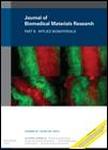版权所有:内蒙古大学图书馆 技术提供:维普资讯• 智图
内蒙古自治区呼和浩特市赛罕区大学西街235号 邮编: 010021

作者机构:Department of Bioengineering Rice University P.O. Box 1892 MS-142 Houston Texas 77251-1892 Department of Electrical and Computer Engineering Rice University Houston Texas 77251
出 版 物:《Journal of Biomedical Materials Research Part B: Applied Biomaterials》
年 卷 期:2000年第51卷第3期
学科分类:1001[医学-基础医学(可授医学、理学学位)] 10[医学]
主 题:nanotechnology NIPAAm hydrogel medical lasers controlled release
摘 要:Composites of thermally sensitive hydrogels and optically active nanoparticles have been developed for the purpose of photothermally modulated drug delivery. Copolymers of N -isopropylacrylamide (NIPAAm) and acrylamide (AAm) exhibit a lower critical solution temperature (LCST) that is slightly above body temperature. When the temperature of the copolymer exceeds the LCST, the hydrogel collapses, causing a burst release of any soluble material held within the hydrogel matrix. Gold–gold sulfide nanoshells, a new class of nanoparticles designed to strongly absorb near-infrared light, have been incorporated into poly(NIPAAm-co-AAm) hydrogels for the purpose of initiating a temperature change with light; light at wavelengths between 800 and 1200 nm is transmitted through tissue with relatively little attenuation, absorbed by the nanoparticles, and converted to heat. Significantly enhanced drug release from composite hydrogels has been achieved in response to irradiation by light at 1064 nm. We have investigated the release of methylene blue and proteins of varying molecular weight. Additionally, the nanoshell-composite hydrogels can release multiple bursts of protein in response to repeated near-IR irradiation. © 2000 John Wiley & Sons, Inc. J Biomed Mater Res, 51, 293–298, 2000.